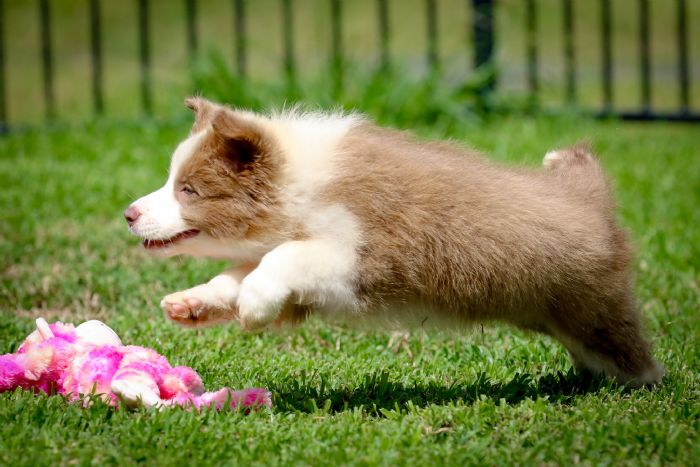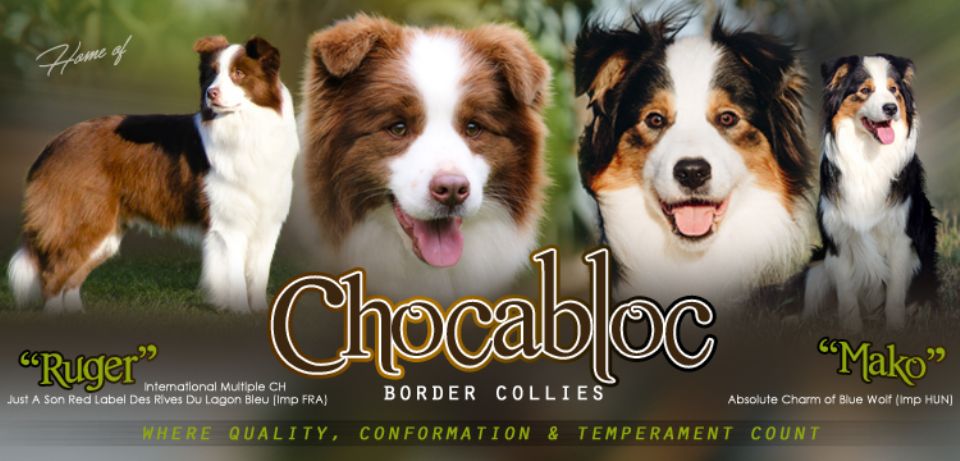Dog Sports

Border Collies are well known for their excellence in dog sports.
I have added a few descriptions below of some extremely fun and rewarding canine sports that you may consider participating in with your Border Collie.
AGILITY
Agility is a fun sport that gets you out and about with your dog, not to mention the exercise that you are both getting out there in the sunshine and fresh air.
Agility is a dog competition open to all dogs. The aim of this competition is for a Handler to direct his dog around a course of different obstacles to assess and enhance the ability of the dog and Handler to work as a team. It is an educational and sporting activity intended to improve the dog's integration into society. The sport requires a good rapport between dog and Handler, which results in perfect teamwork. Whilst speed of the dog is to be desired, steadiness of work is essential to a faultless performance of the course.
The handler directs the dog through an obstacle course in a race for both time and accuracy. Dogs run off-leash with no food or toys as incentives, and the handler can touch neither dog nor obstacles. Consequently the handler's controls are limited to voice, movement, and various body signals, requiring exceptional training of the animal and coordination of the handler.
In its simplest form, an agility course consists of a set of standard obstacles laid out by a judge in a design of his or her own choosing in an area of a specified size. The surface may be of grass, dirt, or rubber. Depending on the type of competition, the obstacles may be marked with numbers indicating the order in which they must be completed.
Courses are complicated enough that a dog could not complete them correctly without human direction. In competition, the handler must assess the course, decide on handling strategies, and direct the dog through the course, with precision and speed equally important. Many strategies exist to compensate for the inherent difference in human and dog speeds and the strengths and weaknesses of the various dogs and handlers.
Agility Trials are open to dogs and owners registered with the Canine Control of either sex and 18 months of age or over. Events are Agility, Jumping, Games and any other activities including but not limited to Snooker, Gamblers and Strategic Pairs.
Its the best way to get some exercise while still having fun. Border Collies love agility, its fast, fun and mentally challenging. What a great combination! And look at the bright side, at least one of you will be fit :)
HERDING
Border Collies really enjoy doing what they were bred for.They are known for their excellent eye and understanding of stock whilst being gentle but forceful.
All dogs six (6) months of age or older that are registered with the ANKC are
eligible to participate in Herding Tests and Trials. De-sexed dogs, dogs with Limited Registration and dogs that have faults which would disqualify them under their breed standards may participate in Tests and Trials.
Around the world, herding dogs have proven themselves to be essential in improving man’s ability to control and move stock. Many herding dogs have working styles very different to the modern sheep dogs we see in Australia today. These different herding styles developed in response to local situations and needs.
As the breeding, pedigree recording, and exhibition of these dogs progressed, many have been accepted as pure breeds. Herding instinct is a precious part of a herding breed’s heritage. It is also a vital component that can be easily lost when breeding for exhibition in the show ring.
The ANKC Herding Program is designed to preserve the traditional style and herding instinct of these many breeds. Herding Tests and Trials provide a standardised gauge by which a dog’s basic instinct and ability can be measured, and allow dogs to demonstrate the useful functions for which they were originally developed. Livestock used for herding includes sheep, cattle and ducks.
OBEDIENCE
Obedience is one of the most rewarding and beneficial things you can do for your dog. Obedience training ranges from very basic training, such as teaching the dog to reliably respond to basic commands such as "sit", "down", "come", and "stay", to high level competition within clubs. Obedience is a doorway into many other fields. For many owners, they want a dog that will come when called, stay still if need be and "go fetch" and having once slobbered all over the ball they bring the ball back! For others, the goal is competition. It's an exciting sport that ranges from heeling on lead and calling your dog, to the very advanced work of scenting along a track, retrieving and jumping obstacles. For others, Obedience is a stepping-stone into other sports such as Dog Dancing (also known as Canine Freestyle and Heelwork to Music), Agility, Flyball, just to name a few.
Basic or beginner's obedience is typically a short course ranging from six to ten weeks, where it is demonstrated to the handler how to communicate with and train the dog in a few simple commands. With most methods the dog is trained one command at a time. Though there may or may not be a specific word attached to it, walking properly on a leash, or leash control, is often the first training required prior to learning other commands.
CANINE FRISBEE
Once you have mastered a straight throw and your dog is catching and returning the frisbee/disc reliably, you are ready to play Toss an Fetch. Some BARK competitions also include a Freestyle section. This is more challenging, and you and your dog will perform moves choreographed to music....twists, vaults and multiple catches just to name a few.
It is a great sport for keeping you and your dog active. It is inexpensive and can be played by even the youngest member of the family.
FLYBALL
Flyball encompasses all things that dogs love to do - jumping, catching, retrieving, competing and striving to please their owners. Flyball is a sport in which any dog can participate, regardless of breed, shape or size.
Flyball is a relay race between two teams of four dogs. Racing side by side, one dog from each team must go over four hurdles, trigger a flyball box pedal, catch (retrieve) a ball and then return over all four hurdles to the start/finish gate where the next dog eagerly awaits.
Flyball is a team sport. Each team consists of four dogs racing in each heat, plus up to two reserves. Reserves can be interchanged after each heat. There are between three and five heats to a race, and a team has to win a majority to win the race.
Besides being great for dogs, flyball is a lot of fun for people too! It is a great way to meet people locally and all around Australia. The team-work aspects bring people together as they strive to improve their team's performance. Flyball can be as competitive as you want to make it. The best part of all is just having fun with your dog, and seeing the look of excitement on your dog's face at the start of a day of racing, and the look of content at the end of the day.
SHOWING
Dogs at a conformation show are judged by how closely they resemble their breed standard. Breeders try to breed dogs that match the standard for their particular breed. At a show a judge awards places to dogs in the order that, in their opinion, reflects the breed standard. The breed standards were originally written to describe a particular breed of dog with the best possible physical and temperamental characteristics to perform the tasks for which they were originally bred. Therefore, the point of a dog show is to recognise and reward those exhibitors who present dogs that most closely resemble the breed standard. That's the theory, anyway!
Even if you choose not to participate in any of the above dog sports we recommend that you at least attend your locally run Puppy Preschool. You will both learn some invaluable lessons that will give you both a solid base for a happy dog/owner relationship.
Contact Details
Louise Stonehouse
Wide Bay QLD, Australia
Email : [email protected]
